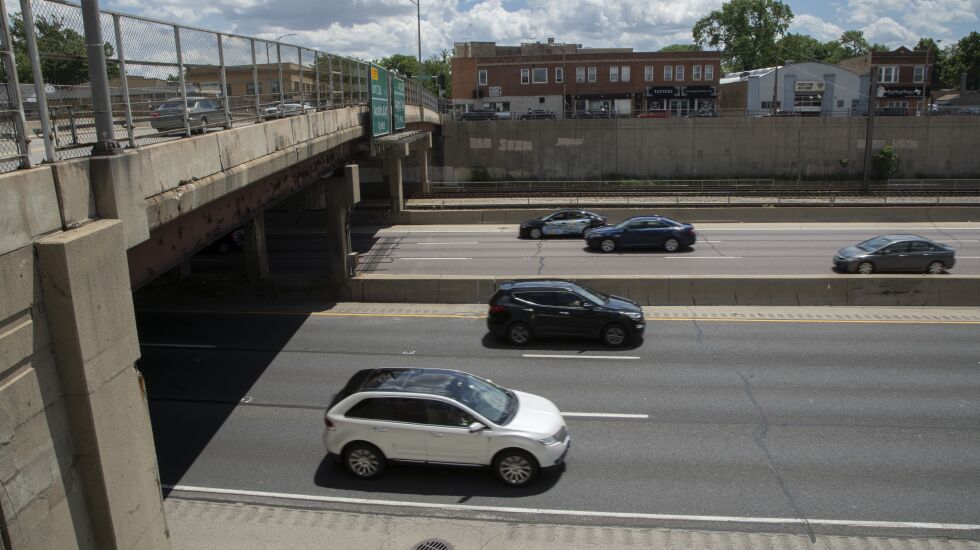
An idea emerged several years ago to “cap the Kennedy,” or build a landscaped deck over portions of the Kennedy Expressway as it courses through downtown Chicago. The concept is still out there but with no funding source, grassroots advocacy or engineering studies to bolster it.
That could change if the federal government opens the taps for infrastructure money. It turns out, though, that a similar idea in the region might have a spot in line ahead of the Kennedy project. It comes from the village of Oak Park, which over some 20 years has discussed and analyzed plans for landscaped decks over parts of Interstate 290, the Eisenhower Expressway. Residents have voiced support for the plan, but they haven’t seen hard numbers about their share of the cost.
A volunteer “Cap the Ike” group submitted a report to the village in 2003 that called for a full study and noted the success other cities had with capping expressways or principal roads, beautifying the landscape while uniting neighborhoods torn up by the original construction. The village responded with a report in 2005 that analyzed the idea from several angles, including the need to coordinate with the Illinois Department of Transportation and the CTA, because its Blue Line runs down the middle of the highway. The report reviewed three design alternatives, from modest enhancements to a deck over the town’s entire stretch of the Ike between Austin and Harlem avenues. Residents liked that last alternative the best, the report said, even though its estimated cost in 2005 was $1.56 billion. Figure on $2.3 billion today.
By 2016, the village scaled back its ambitions, releasing a design study for decking over only parts of the Ike. Village Engineer Bill McKenna said Oak Park has been waiting for IDOT to approve work and to announce its own plans to upgrade the Ike. Most of the pavement and bridges date from the 1950s.
“These would not be cheap improvements,” McKenna said. Federal funding would be great but there would have to be a local match. McKenna said the Village Board has identified the Eisenhower as among its priorities for capital spending.
Oak Park’s 2016 plan called for the largest decks at East and Oak Park avenues, running up to 500 feet east from those overpasses. Goals of the work include providing new land for open space and athletic fields, a connection for a fragmented business district and more attractive transit access, according to a village summary. It also said the Oak Park Avenue enhancements could include a commercial building spanning the I-290 divide.
Guy Tridgell, spokesman for IDOT, said the agency has not included Eisenhower reconstruction in its five-year capital plan that runs through 2027. Tridgell said IDOT and the CTA have jointly applied for federal money to improve storm sewers for the Eisenhower and modernize some Blue Line stations, work necessary for an eventual reconstruction of the expressway. He said the agency is on the lookout for other federal funding and will work with communities on design issues.
Highway capping or beautification projects could be in line for up to $1 billion in the federal infrastructure bill passed last year. The law created the Reconnecting Communities Pilot Program, with money set aside over five years. It’s an acknowledgment that the interstate highway system, for all its benefits, was unkind to urban areas. The chosen routes tended to reinforce segregation and, whether built in trenches or as towering bridges, added to blight.
Audrey Wennink, transportation director for the Metropolitan Planning Council, said the group supports efforts to better link highways to the communities they pass through. “We know the Eisenhower is at the end of its useful life and that’s an opportunity to think creatively about how to improve it and how to mitigate harms done by the interstate era,” she said.

There will be lots of competition for the money. Capping highways is popular in some quarters, but the costs and who gets subsidized raise issues of equity. If Oak Park, a wealthy suburb, gets money for highway beautification, why not Chicago’s West Side? The same critique could apply to any “cap the Kennedy” improvement benefiting West Loop landowners.
A Washington, D.C. group, Congress for the New Urbanism, has cataloged success other cities have had with roadway removal or decking. Examples include Boston, Milwaukee, Seattle and San Francisco. Boston’s “Big Dig” became notorious for cost overruns from putting a highway underground in a coastal city. But Wennink said that on a visit there she found the results spectacular. “There are all these linear parks that have made the city so much more walkable,” she said.
Add less noise and pollution to the equation and maybe decking over a highway is something the Chicago area will try someday despite the costs. It could be our first “cover-up” for the public good.








